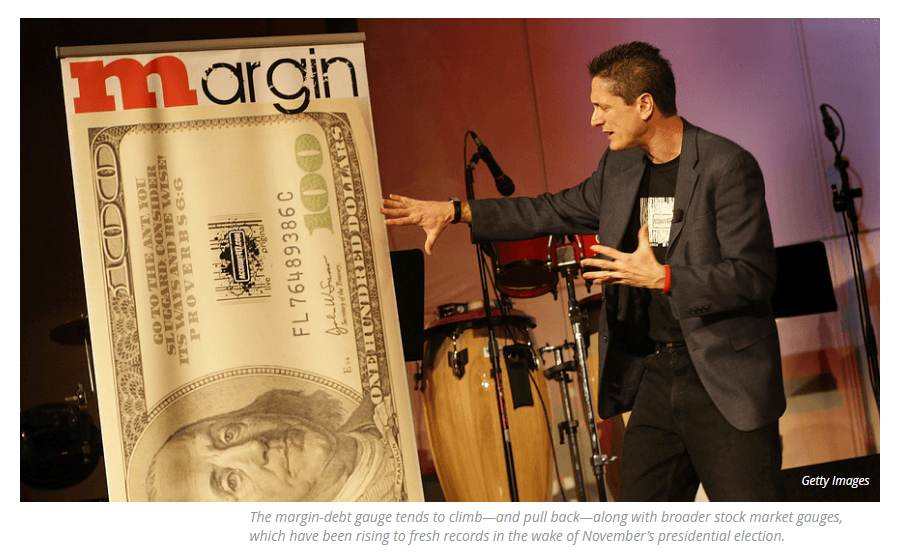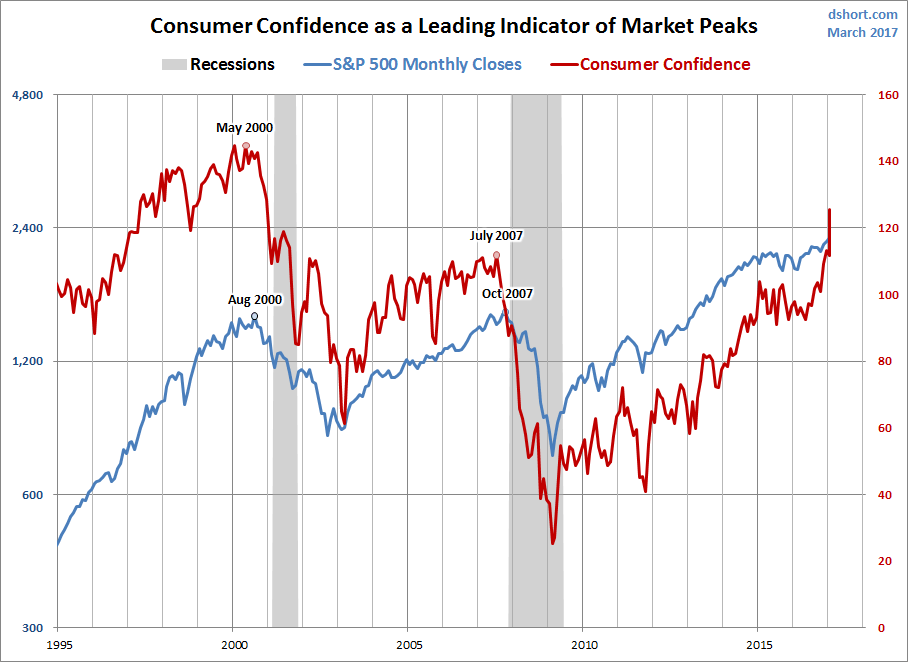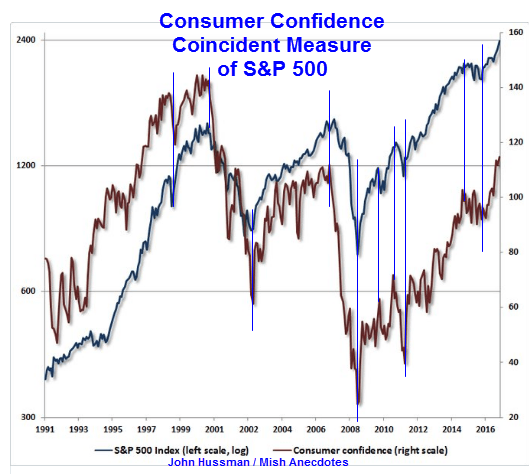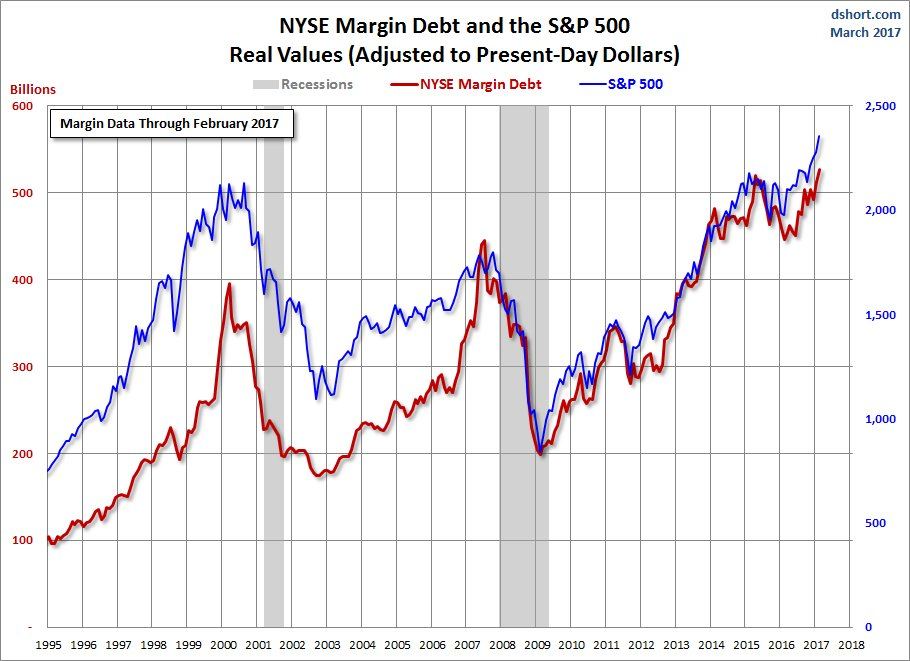The Wall Street Journal reports Margin Debt Hit an All-Time High in February. Given that Margin debt has a history of peaking right before financial collapses this seems like a warning to me but analysts say it's different this time.
Margin debt climbed to a record high in February, a fresh sign of bullishness for flummoxed investors trying to navigate the political and economic crosscurrents driving markets.
The amount investors borrowed against their brokerage accounts climbed to $528.2 billion in February, according to the most recent data available from the New York Stock Exchange, released Wednesday. That is up 2.9% from $513.3 billion in January, which had been the first margin debt record in nearly two years.
Before January, the previous record high for margin debt was $505 billion in the spring of 2015. Margin debt then started falling, months ahead of a summer swoon that sent major indexes down more than 10%.
Analysts Say Don't Worry
MarketWatch reports Record Margin Debt May Be a Red Flag, but Analysts Say Don't Worry.
The latest warning sign — following underperformance by small-cap stocks, record y it’s different this time. inflows into exchange-traded funds and high levels of political uncertainty — is margin debt, which is seen as a measure of speculation and just broke a record that has stood for nearly two years.
Don't worry.
According to the most recent data available from NYSE, margin debt hit a record of $513.28 billion at the end of January, topping a previous record of $507.15 billion that had held since April 2015. Margin debt refers to the money that investors borrow to buy stocks, and high levels of it, in periods of market volatility, and can lead to sharper declines. Records preceded both the dot-com market crash and the financial crisis.
However, expecting a similar correction because debt is at a record now would be "naïve," said Jeff Mortimer, director of investment strategy for BNY Mellon Wealth Management.
"This isn't a signal to me that markets are reaching an exuberant level like they did in the 1920s or 1990s, when speculation was rampant," he said. "What our clients are doing is borrowing against the portfolios because interest rates are so low. They're not leveraging up because they see the market exploding to the upside; they're using leverage because they can pay it off at any time."
Borrowing Against Portfolios
Don't worry, clients are just borrowing against their portfolios because rates are low. Allegedly, they can pay this back anytime.
Excuse me for asking, but what if they spent the money?
Consumer Confidence a Leading Indicator of Market Tops?
In response to Consumer Confidence Strongest Since December 2000: A Strong Contrarian Indicator? I received an interesting chart from Doug Short at Advisor Perspectives.
Once again, here is a chart from John Hussman to which I added vertical bars.
For now, I am sticking with consumer sentiment as a coincident, not leading indicator unless the markets make a fresh set of highs.
Hussman Tweeted, and I strongly agree, "Multi-year highs in consumer confidence are less a sign of forthcoming consumer spending as a sign of forthcoming investor losses."
This material is based upon information that Sitka Pacific Capital Management considers reliable and endeavors to keep current, Sitka Pacific Capital Management does not assure that this material is accurate, current or complete, and it should not be relied upon as such.
Recommended Content
Editors’ Picks
EUR/USD edges lower toward 1.0700 post-US PCE

EUR/USD stays under modest bearish pressure but manages to hold above 1.0700 in the American session on Friday. The US Dollar (USD) gathers strength against its rivals after the stronger-than-forecast PCE inflation data, not allowing the pair to gain traction.
GBP/USD retreats to 1.2500 on renewed USD strength

GBP/USD lost its traction and turned negative on the day near 1.2500. Following the stronger-than-expected PCE inflation readings from the US, the USD stays resilient and makes it difficult for the pair to gather recovery momentum.
Gold struggles to hold above $2,350 following US inflation

Gold turned south and declined toward $2,340, erasing a large portion of its daily gains, as the USD benefited from PCE inflation data. The benchmark 10-year US yield, however, stays in negative territory and helps XAU/USD limit its losses.
Bitcoin Weekly Forecast: BTC’s next breakout could propel it to $80,000 Premium

Bitcoin’s recent price consolidation could be nearing its end as technical indicators and on-chain metrics suggest a potential upward breakout. However, this move would not be straightforward and could punish impatient investors.
Week ahead – Hawkish risk as Fed and NFP on tap, Eurozone data eyed too

Fed meets on Wednesday as US inflation stays elevated. Will Friday’s jobs report bring relief or more angst for the markets? Eurozone flash GDP and CPI numbers in focus for the Euro.



